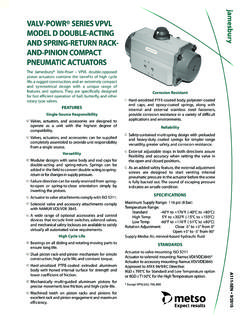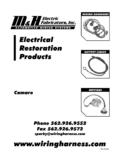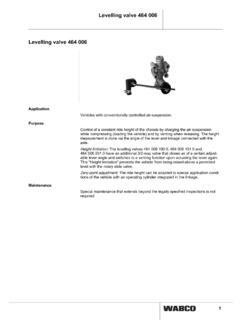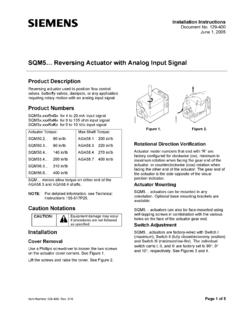Transcription of Samson Type 3766 Type 3767 - msp-maad.com
1 Pneumatic Positioner Type 3766 Electropneumatic Positioner Type 3767 Application Single-acting or double-acting positioners for attachment to pneumatic control valves. Supplied with a pneumatic input signal to 1 bar or 3 to 15 psi (Type 3766 ) or an electric input signal from 4(0) to 20 mA or 1 to 5 mA (Type 3767 ). Rated travels from to 120 mm or opening angle up to 90 JIS The positioners ensure a fixed assignment between the valve stem position (controlled variable x) and the pneumatic or electric in put signal (reference variable w). They compare the input signal received from the control unit with the travel of the control valve and, issue the corresponding output signal pressure pst (output variable y).
2 A reversing amplifier for double-acting actuators produces two opposed signal pressures. Special features Arbitrary mounting position; suitable for normal or split-range operation; excellent dynamic response; negligibly small influence of supply air; adjustable proportional band (P-band); adjustable air output capacity; low air supply con sumption; very insensitive to mechanical vibrations; low-maintenance compact design Versions for hazardous areas in type of protection "Intrinsic Safety" II 2 G EEx ia IIC T6 or II 3 G EEx nA II T6 for Zone 2 (see "Summary of approvals") Type of protection "Flameproof Enclosure" EEx d with Type 3766 Positioner and Type 6116 i/p Converter (Fig.)
3 2) Special version with CrNiMo steel housing available Direct attachment to Type 3277 Pneumatic Actuator (Fig. 4) Attachment to actuators according to IEC 60534-6 (Fig. 3) Attachment to rotary actuators acc. to VDI/VDE 3845 (Fig. 5) Benefits of integral positioner attachment (Fig. 4) Tight and exact mechanical connection between actuator and positioner. No misalignment during shipping Concealed linkage protected against touch and external in fluences to fulfill requirements of accident prevention regula tions UVV (VBG 5) Simple pneumatic connection between actuator and positioner Presetting of the unit: Actuator with positioner Optional pressure gauge for monitoring the input and output signal pressure (dial range from 0 to 6 bar and 0 to 90 psi).
4 Refer to Information Sheet T 8350 EN for details on the selection and application of positioners, converters, limit switches and solenoid valves. Versions Type 3766 Pneumatic positioner Type 3767 Electropneumatic positioner Refer to article code for details on possible configurations. Fig. 1 Type 3767 Electropneumatic Positioner Fig. 5 Attachment to Type 3278 Rotary Actuator Fig. 4 Direct attachment to Type 3241-7 Control Valve Fig. 3 Attachment acc. to IEC 60534 (NAMUR) Fig. 2 Type 3766 Ex d Positioner with Type 6116 i/p Converter Associated Information Sheet T 8350 EN Edition January 2010 Data Sheet T 8355 EN Principle of operation (Figs.)
5 6 to 8) The only difference between the two positioners is an i/p con verter unit (E) in the electropneumatic positioner. Both positioners function according to the force-balance principle. In the Type 3767 Electropneumatic Positioner, the control signal (i) flows through the plunger coil (E2) in the field of a permanent magnet (E1). The force, proportional to the DC current i, is bal anced against the force of the backpressure at the balance beam (E3) which is created at the flapper plate (E7) by the jet stream leaving the nozzle (E6). Any changes in the signal cause a proportional change in the pressure pe supplied to the pneu matic control system.
6 The pressure pe creates a force at the measuring diaphragm (5) which is compared to the force of the range spring (4). If the control signal causes the pneumatic input pressure (pe) or the position of the lever (1) to change, the diaphragm lever (3) func tioning as a flapper plate varies the distance to the nozzle ( or ). The position of the internal turnboard for the operating direction (7) determines which nozzle is effective. The pneumatic booster (10) and the pressure regulator (9) are provided with supply air. The controlled supply flows against the diaphragm lever (3) over the Xp restriction (8) and the noz zle ( or ). Any changes in the control signal or the posi tion of the lever (1) cause a variation of pressure both upstream and downstream of the booster (10).
7 The output signal pressure pst issued by the booster flows over the volume restriction (11) to the actuator and positions the valve to match the input signal. The travel is transmitted to the pick-up lever (1) via the pin ( ) in globe valves. Whereas, in rotary valves (Fig. 8), a cam follower roll (20) is attached to the front end of the pick-up lever (1) which follows the rotary motion of a cam disk (22) on the ac tuator shaft (21). The force of the range spring (4) is changed by the linear motion of pick-up lever. The positioner must be fitted with a reversing amplifier for at tachment to double-acting actuators, which generates two op posed signal pressures (pst1 and pst2).
8 The adjustable restrictions Xp (8) and Q (11) are used to opti mize the control loop. Two adjusting screws ( and ) allow the adaptation of the control valve to the signal pressure. ZERO and SPAN of the reference variable can be adjusted for different operating modes, such as split-range operation. Operating direction: As the reference variable (pe) increases, the output signal pressure (pst) can either be increasing (direct >>) or decreasing (reverse <>). The operating direction is deter mined by the position of the turnboard (7) and can be changed subsequently. Legend for Figs. 6 to 8 1 Lever E i/p converter unit Pin E1 Permanent magnet Rotary shaft E2 Plunger coil Nozzle (>>) E3 Balance beam Nozzle (<>) E4 Universal joint 3 Diaphragm lever (flapper) E5 Spring 4 Range spring E6 Nozzle 5 Measuring diaphragm E7 Flapper plate Adusting screw (SPAN) E8 Restriction Adusting screw (ZERO) E9 Damping 7 Turnboard for op.
9 Direction E10 Protective diode 8 Xp restriction (gain) 9 Pressure regulator 10 Booster 20 Cam follower roll 11 Volume restriction Q 21 Actuator shaft 12 Solenoid valve (optional) 22 Cam disk 4 3 5 1 Pe mAE10 E3 E7 E6 E9 E4 E5 E2 E1 E E8 V Q Xp 7 8 9 10 11 12 e p Fig. 7 Functional diagram of Type 3767 Positioner 4 3 5 1 V Q Xp 7 8 9 10 11 12 e p Fig. 6 Functional diagram of Type 3766 Positioner (deflection of pick-up lever in case of direct attachment to Type 3277 Pneumatic Actuator) Travel Operating direction Control signal pe Supply air Output signal pressure pst Fig. 8 Transmission of rotary motion to the positioner Travel Press.
10 Reg. Control signal pe Supply air Output signal pressure pst Operating direction T 8355 EN 2 Table 1 technical data All pressures in bar (gauge) Type 3766 and Type 3767 Positioners Travel range Direct attachment to Type 3277 Actuator: .. 30 mm Attachment acc. to IEC 60534 (NAMUR): .. 120 mm Opening angle 70 , 75 or 90 depending on cam disk Reference variable w Type 3766 Signal range bar (psi) .. 1 bar (3 .. 15 psi) Span bar (psi) .. bar (6 .. 12 psi) Overloadabe max. 2 bar (29 psi) Reference variable w Type 3767 Signal range Two-wire device, reverse polarity protection 4(0) .. 20 mA 1 .. 5 mA Span 8 .. 20 mA 2 .. 4 mA Internal resistance Ri at 20 C 200 880 Supply air Supply air range.







